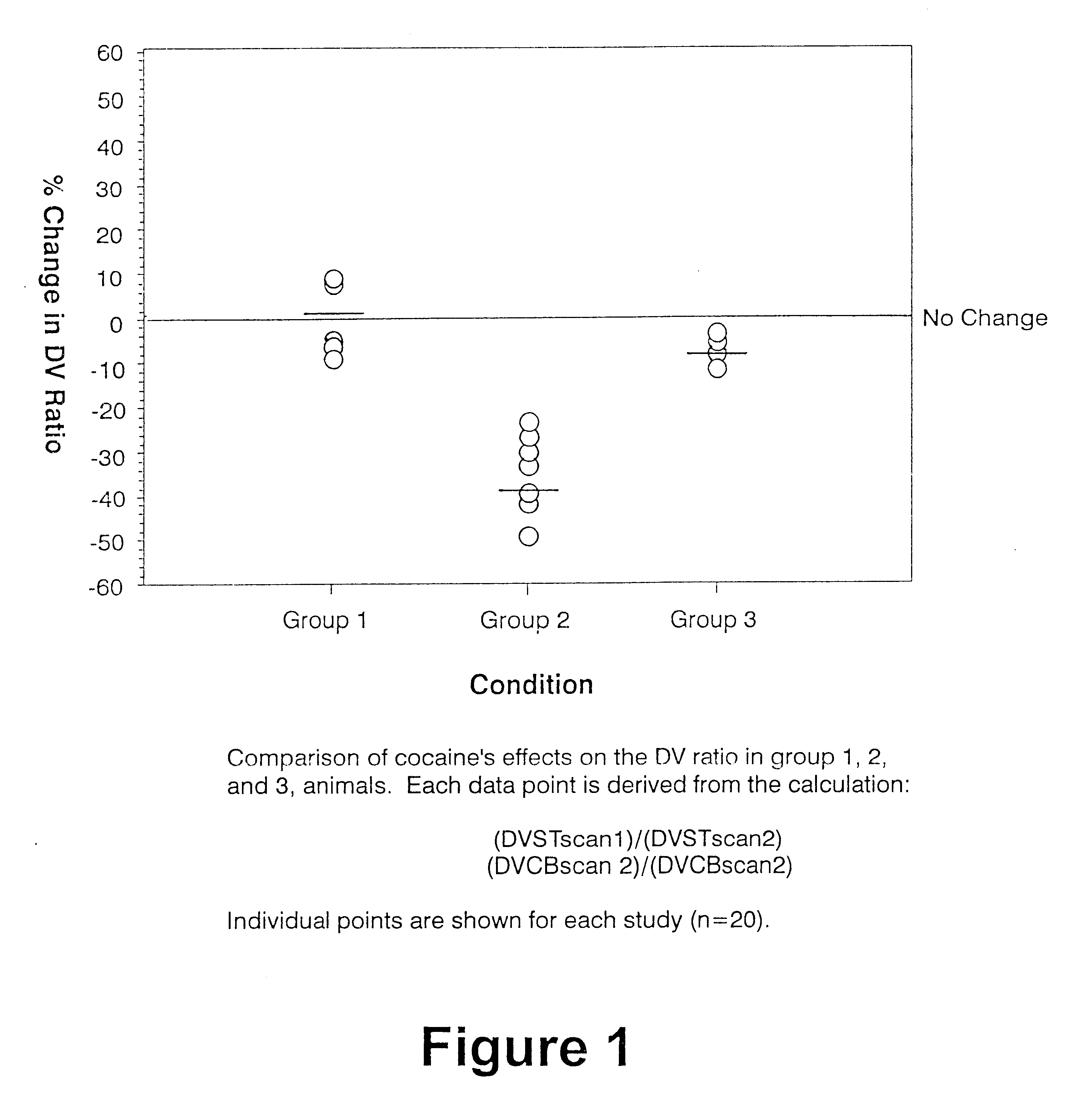Treatment of addiction to ethanol and addictive-related behavior
a technology of addiction and ethanol, applied in the field of treatment of addiction to ethanol and addictive-related behavior, can solve the problems of gastrointestinal absorption slowness, dopamine deficiency, devastating consequences, etc., and achieve the effect of not affecting the rate of drug intake, reducing break points, and reducing rewards/reinforcing actions
- Summary
- Abstract
- Description
- Claims
- Application Information
AI Technical Summary
Benefits of technology
Problems solved by technology
Method used
Image
Examples
example 1
Non-Human Primate (Baboon) Studies
In this example twenty non-human primates received two [.sup.11 C]-raclopride injections in accordance with the procedure described in Section 1 of Materials and Methods. The first served as a baseline and the second followed cocaine or placebo. Test / retest primates (n=7) shown as Group 1 of Table 1 below received placebo (0.9% saline, 1 ml / kg) prior to the second radio tracer injection in order to determine the test / retest variability of this imaging method.
All remaining primates (n=13) received a systemic injection of cocaine hydrochloride (0.5, 1.0 or 2.0 mg / kg) either 5 or 30 minutes prior to the second [.sup.11 C]-raclopride injection. Of these 13 animals, five received GVG (300 mg / kg, iv) 3 hours prior to cocaine administration.
Different cocaine doses and cocaine pretreatment time intervals produced no significant changes in the effects of cocaine on the distribution volume (DV), in line with expectations. Thus, the average % change in the DV ...
example 2
Cocaine-Induced Conditioned Place Preference Studies in Rodents
In this example the procedure outlined in Section 2 of Materials and Methods was followed. Cocaine produced a dose-dependent CPP response, with the most reliable and robust response occurring at 20 mg / kg as shown in Table 2 below.
We therefore chose a 20 mg / kg cocaine dose with which to examine the effect of GVG administration on the acquisition and expression phases of cocaine-induced CPP. The results clearly indicated that 112, 150 and 300 mg / kg, but not 75 mg / kg, of GVG blocked the acquisition and expression of cocaine-induced CPP. See specifically Tables 3-10 below.
TABLE III
TABLE V
TABLE V
TABLE VII
TABLE VII
TABLE IX
TABLE X
By itself, GVG produced neither a CPP nor a conditioned aversive response. See again, Tables 3-10.
example 3
Food-Induced Conditioned Place Preference Studies in Rodents
In this example the procedure outlined in Section 3 of Materials and Methods was followed. The results set forth in Table 11 below indicate that food elicited an incentive or rewarding effect. For example, all paired values show that rodents spent more time in the chamber where food was present.
The administration of 150 or 300 mg / kg of GVG did not alter the CPP response to food as shown in Table 11 despite attenuating the incentive motivational effects of cocaine in the above noted CPP experiments a shown in Tables 3-10 above.
Discussion of Experimental Results Obtained in Examples 1, 2 and 3
In previous PET studies, we showed that GVG alone reduces extracellular DA concentrations resulting in an increase in [.sup.11 C]-raclopride binding in the primate brain (Dewey, et al., 1992). In the PET studies of the present invention, GVG-induced decreases in extracellular DA levels prior to cocaine administration clearly underlie the...
PUM
| Property | Measurement | Unit |
|---|---|---|
| height | aaaaa | aaaaa |
| diameter | aaaaa | aaaaa |
| flow rate | aaaaa | aaaaa |
Abstract
Description
Claims
Application Information
 Login to View More
Login to View More - R&D
- Intellectual Property
- Life Sciences
- Materials
- Tech Scout
- Unparalleled Data Quality
- Higher Quality Content
- 60% Fewer Hallucinations
Browse by: Latest US Patents, China's latest patents, Technical Efficacy Thesaurus, Application Domain, Technology Topic, Popular Technical Reports.
© 2025 PatSnap. All rights reserved.Legal|Privacy policy|Modern Slavery Act Transparency Statement|Sitemap|About US| Contact US: help@patsnap.com

